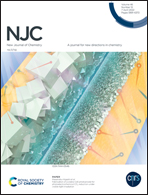Electrochemical activation of CO2 by MOF-(Fe, Ni, Mn) derivatives of 5-aminoisophthalic acid and the thiazole group influence on its catalytic activity†
Abstract
Five new coordination polymers, [Fe(AIP)] (1), [M(L)] [M = Fe (2), Ni (3)], [NiFe(L)] (4), and [Mn(L)] (5) (H2AIP = 5-aminoisophthalic acid, LH2 = 5-((thiazol-2-ylmethyl)amino)isophthalic acid), were synthesized under solvothermal conditions and characterized using ATR-IR spectroscopy, ESR spectroscopy, and elemental analysis; 1 and 5 were characterized by single-crystal X-ray diffraction. Cyclic voltammetry (CV) under a carbon dioxide atmosphere, with an aqueous solution of KCl at 0.1 M, showed that 1 did not show electrochemical activity with CO2. In contrast, complex 2 does work as an electrocatalyst, as it reduces CO2 to CO. Compounds 3 and 4 seem to activate CO2, generating the intermediate type [Ni1+-CO], without electrocatalytic activity. Only complex 5 performs oxidation processes owing to its high electronic stability. From ESR and single-crystal X-ray diffraction, 5 has a Paddle-Wheel agglomerate with an Mn–Mn interaction, not common for [Mn2]4+ type species.



 Please wait while we load your content...
Please wait while we load your content...